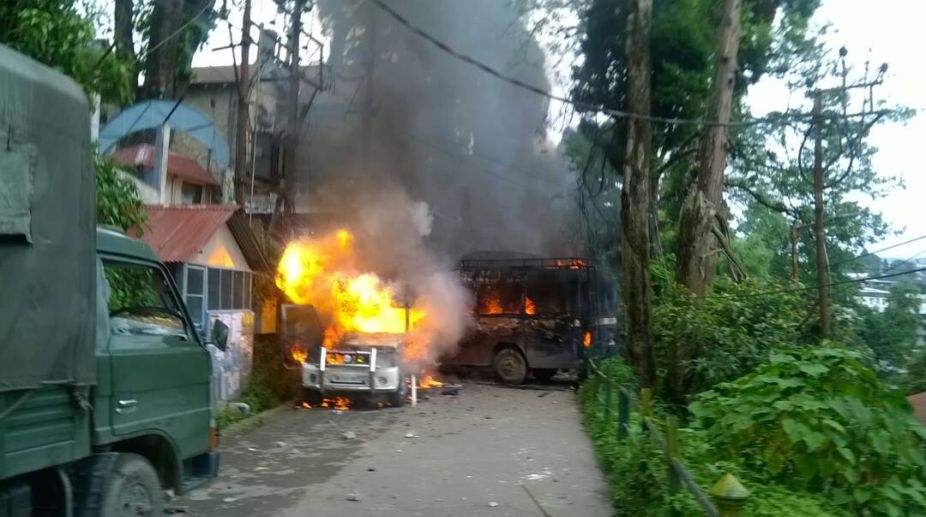Amit Shah promises justice for Gorkhas
Union Home Minister Amit Shah today promised that the Gorkhas in Darjeeling would get justice under the provisions of the Indian Constitution.

(Photo: Twitter)
The Right to Cessation among the people of Darjeeling began to snowball after the formation of Sikkim as a separate state in 1975 at the behest of Indira Gandhi.
The creation of Sikkim also led to a gradual deterioration of Sino-Indian ties as it emerged as an Indian frontier state. The establishment of a strong military base bordering China did have sound strategic reasoning especially after repeated Chinese incursions into the Indian mainland.
However, considering the lingual, ethnic, cultural, social and physical features of the seven states in the North-east, the original mischief was that of colonial rule. For example, the incorporation of Darjeeling within Bengal Presidency by the British was largely arranged so that it could be the summer capital, away from sweltering Calcutta. The ethnic trouble between Gorkhas and the Bengalis began to grow ever since Darjeeling was brought under Bengal to serve the interests of the colonial government.
Advertisement
The British had a special attraction towards the place as they found the weather endearing. While Darjeeling began to offer scope for leisure to the British, the ethnic population was forced to serve them. The locals were deprived of basic education, health and other necessities.
Occupations like Darwan, lift operator and domestic servants happened to be their main source of earning whereas people across India, including the Bengalis thronged Darjeeling to take a view of Paradise on Earth.
Since the beginning of the annexation of Darjeeling by the British within the fold of Bengal, the right to cessation among sons of the soil began to gather momentum. Instead of the British, the main opposition began to brew against the Bengalis, the main beneficiaries of British rule in India.
Whether it is the CPI-M or any other major political party of Bengal, the Gorkhas are completely against them since they see themselves being subjugated by Bengali control.
An opposition party in Bengal may win their confidence temporarily. But once the party secures majority support, the party will lose the faith of Darjeeling's ethnic population. Darjeeling was annexed by the British in 1850, taken from an exceedingly weak Sikkim, a princely state itself annexed by India in 1975.
Bundled into the Bengal Presidency by the British, Darjeeling remained in Bengal even after 1975. This is even after the 1955 States Reorganisation Committee had successfully arranged Indian states according to language. Nepali speaking Darjeeling district is an incongruous part of Bangla-speaking West Bengal.
The States Reorganisation Committee considered a large number of factors to reorganise different states while laying stress on lingua-cultural features of a place or a region. But there was also a strong emphasis on how many people had a particular feature and the extent of the geographical expanse. In the Darjeeling-Sikkim region, Gorkhas are not the only community inhabiting the entire space.
Apart from them, Bhutias, Lepchas, Sherpas and many other communities have been living here for centuries together. But their proximity to the traditional monarch and later the British gave Gorkhas extra mileage and a higher position among the ethnic groups. For example, they could have 'the Gorkha Regiment' wherein only the Gorkhas were recruited becuase of their commendable spirit and valour.
Still, like any other tribal community, they happen to be most backward despite many Gorkhas having wide contact with many illustrious people visiting Darjeeling. The scenic and mesmerising beauty of Darjeeling has charmed almost everyone who visits the place. Bengalis consider Darjeeling their second home and many have the habit of spending a substantial period here during the unfriendly summer.
Though there are now 30 states in the country, no Bengali can imagine losing Darjeeling. Since independence, many opposition parties having their base in the plains of Bengal did support the cause of the Gorkhas to gain political advantage.
Even Ratan Lal Brahman, a candidate of the undivided CPI who won from Darjeeling, supported the Right to Cessation of the tribals, i.e the Gorkhas. But once, the Left formed government in West Bengal, the trouble started with them.
These troubles reached fever pitch in the 1980s until the Darjeeling Gorkha Hill Council ( DGHC) was formed after a tripartite meeting between Rajiv Gandhi, Jyoti Basu and Subhas Ghising. But the incessant corruption and poor performance of DGHC frustrated the aspirations of the Gorkhas and a new torrent of agitation began to sweep the hills after 2007.
This led to the formation of the Gorkha Territorial Administration ( GTA) with more administrative and financial autonomy than the DGHC. But the GTA leaders who once befriended the opposition party in Bengal now began to adopt a stand similar to the one the Gorkhas historically did with the ruling party of Bengal.
Thus the ordeal of Darjeeling based on the ethnic divide between the hills and plainspeople seems to be an endless saga of sorrow as their ultimate demand to create a separate Gorkhaland State fails to hold enough water.
The writer was formerly on the Sociology faculty of Presidency University.
Advertisement